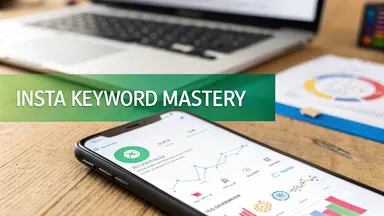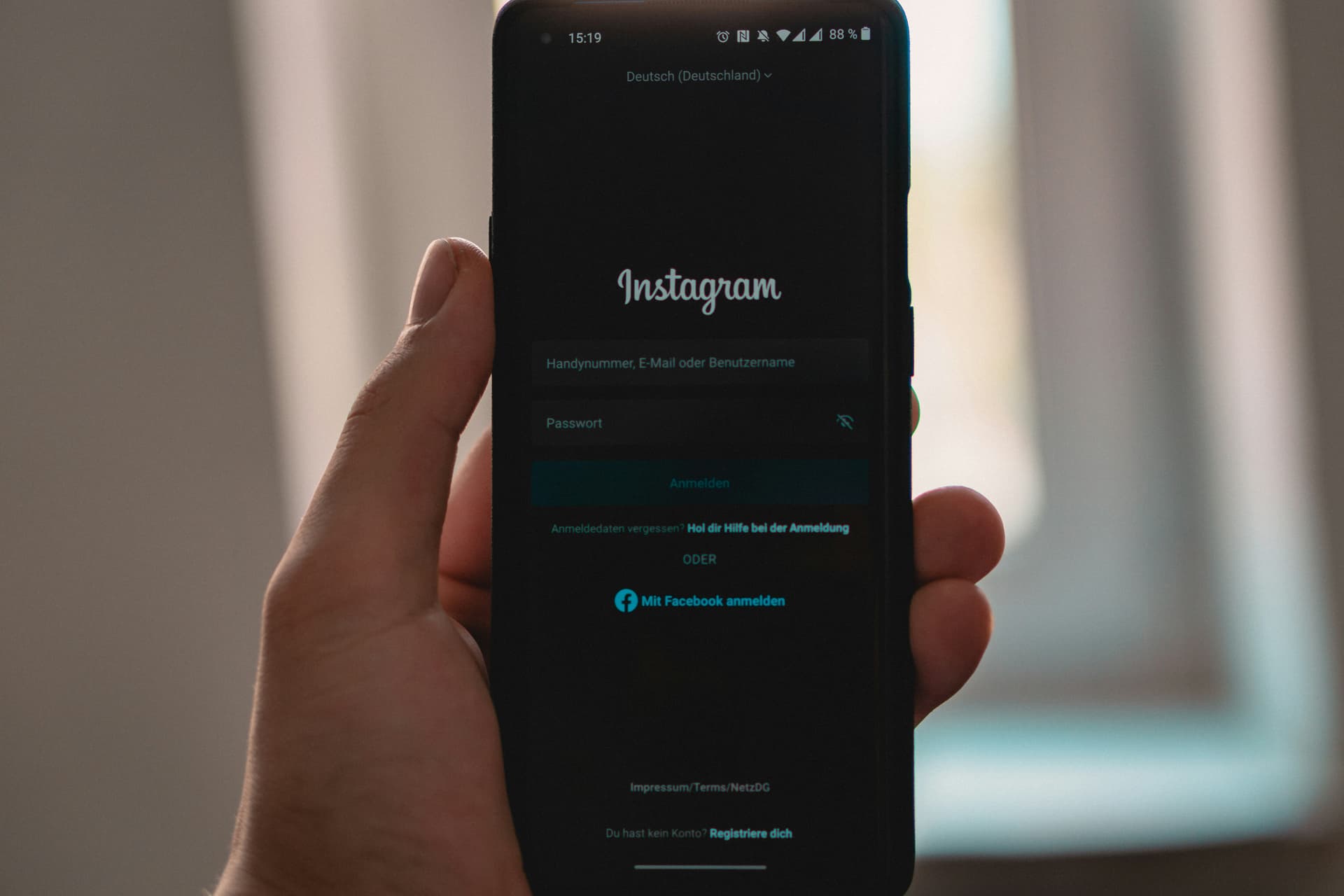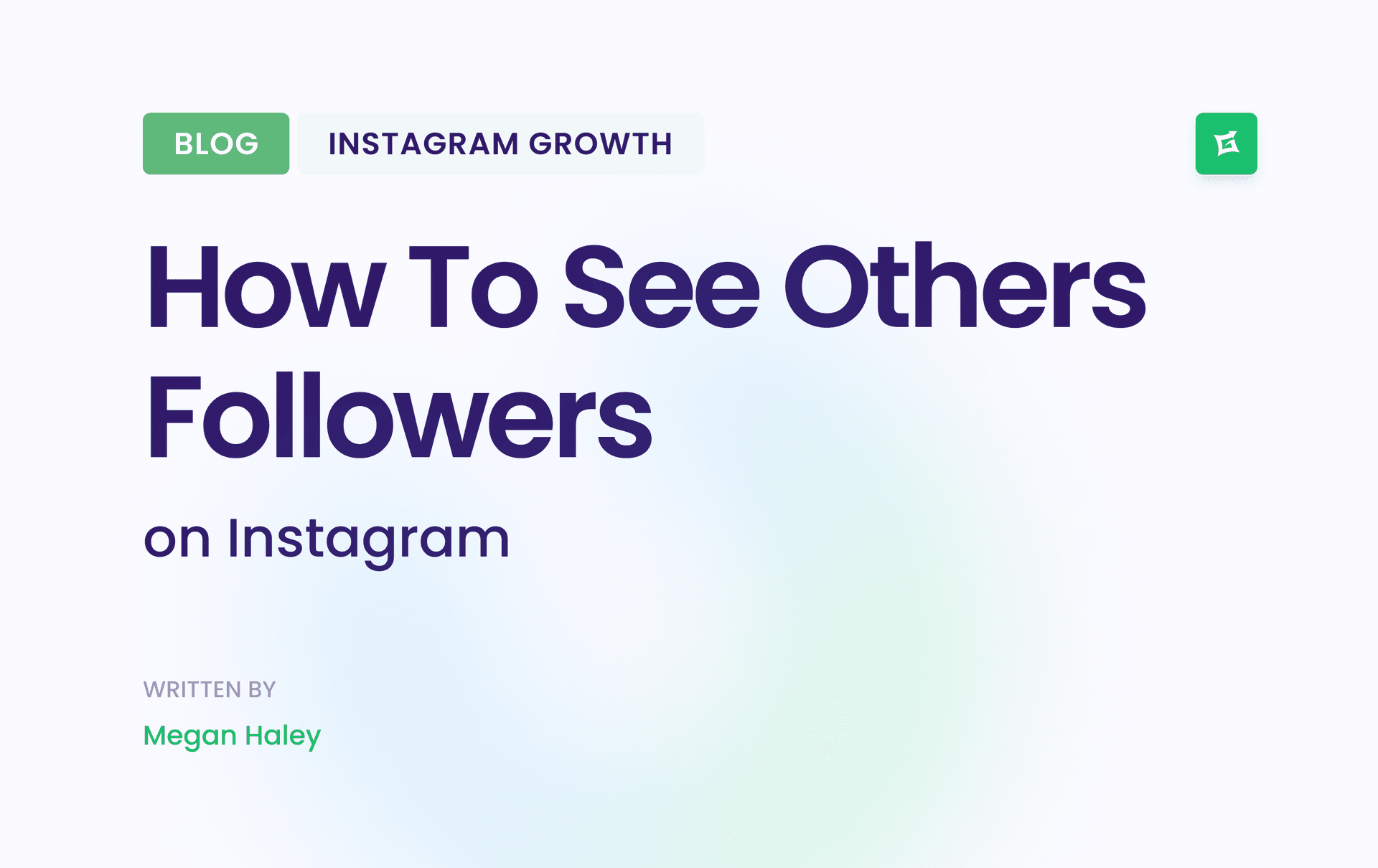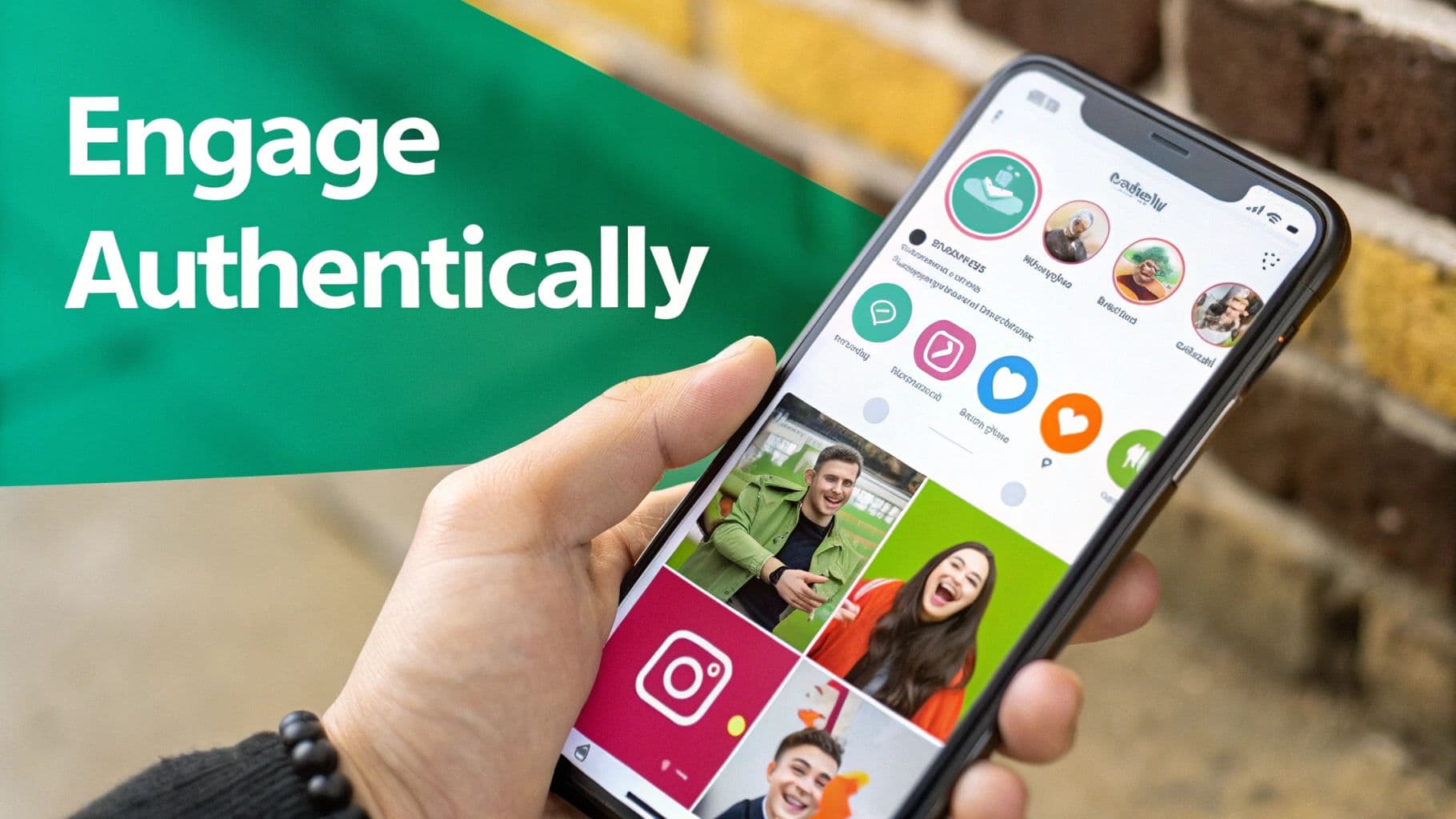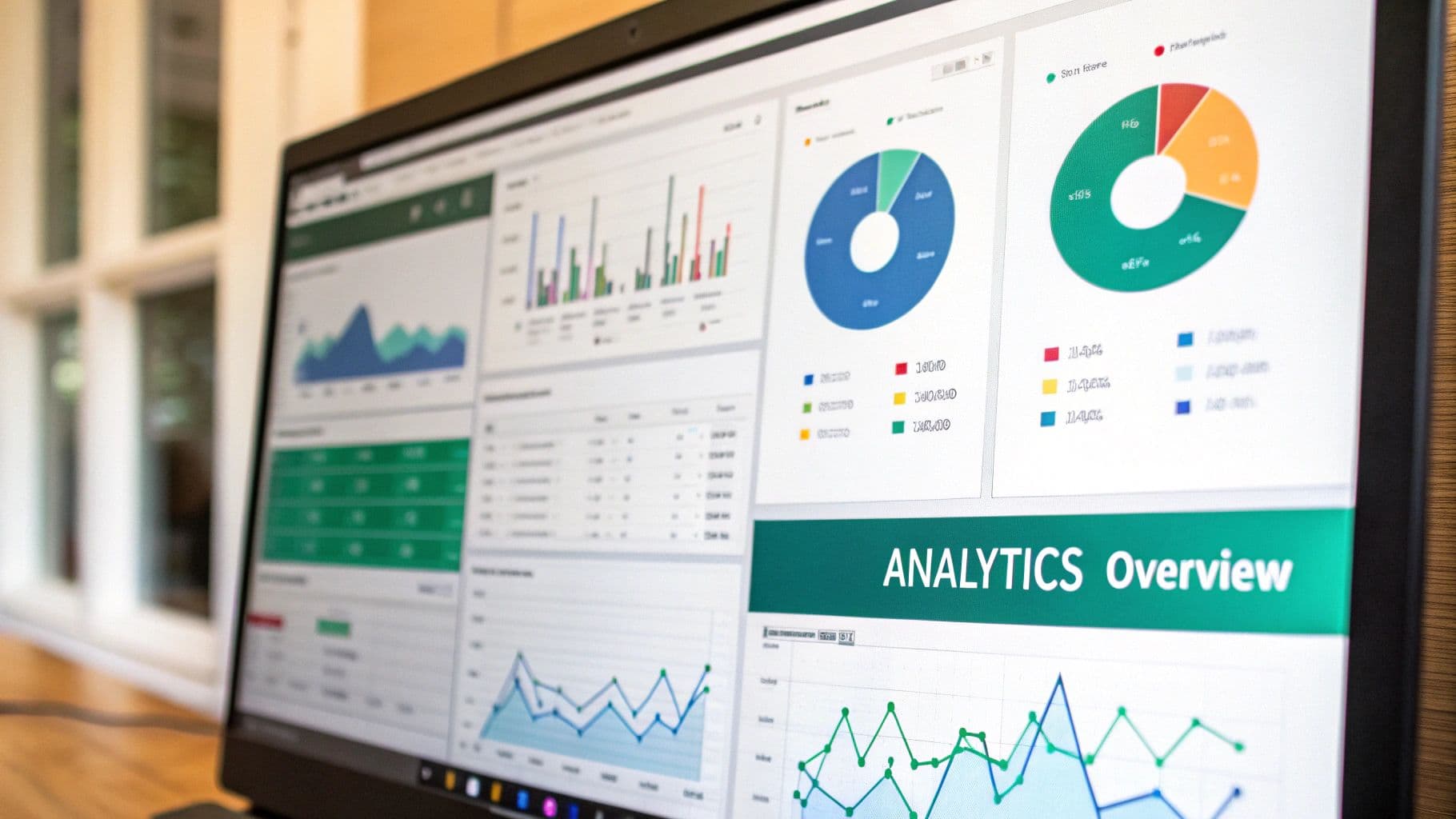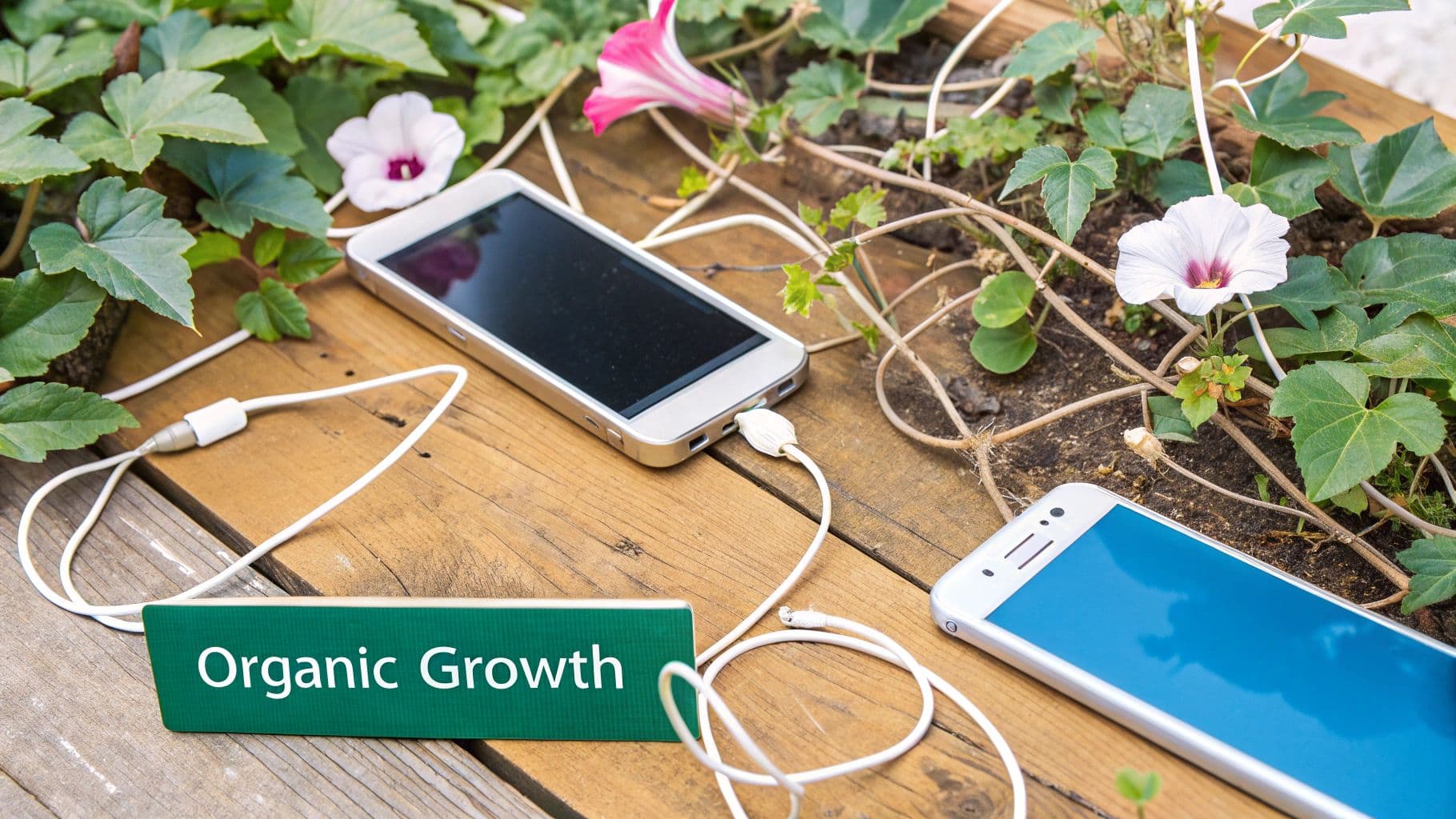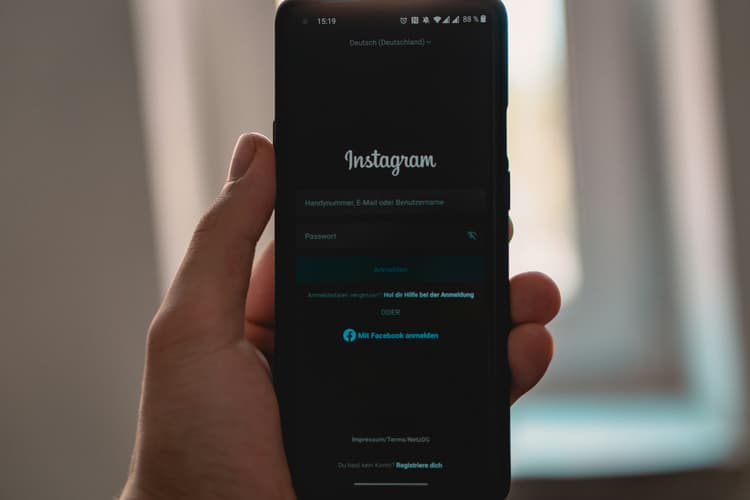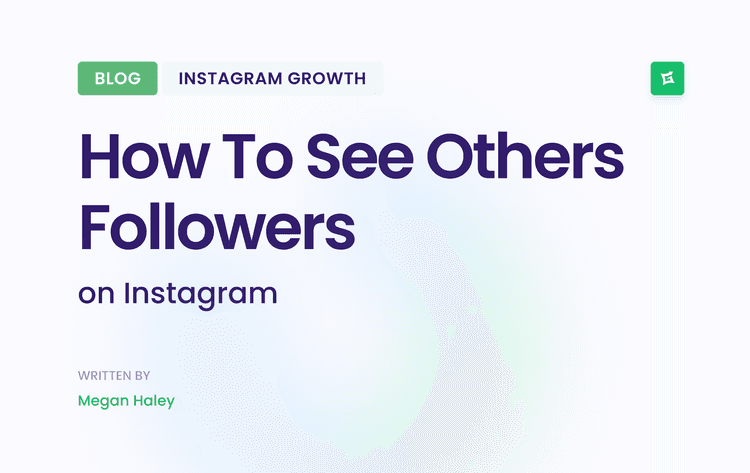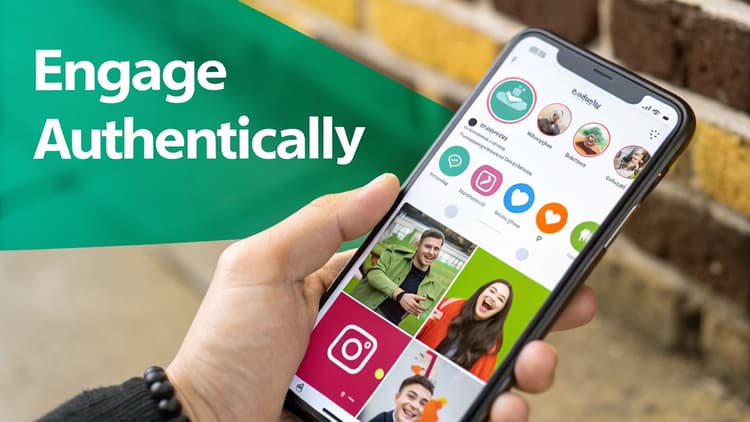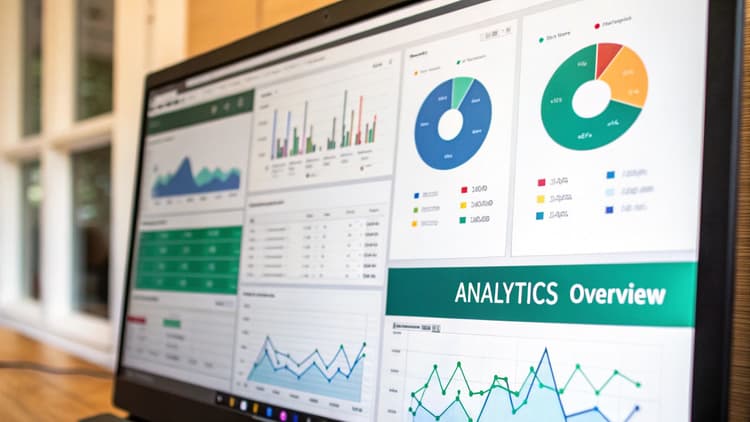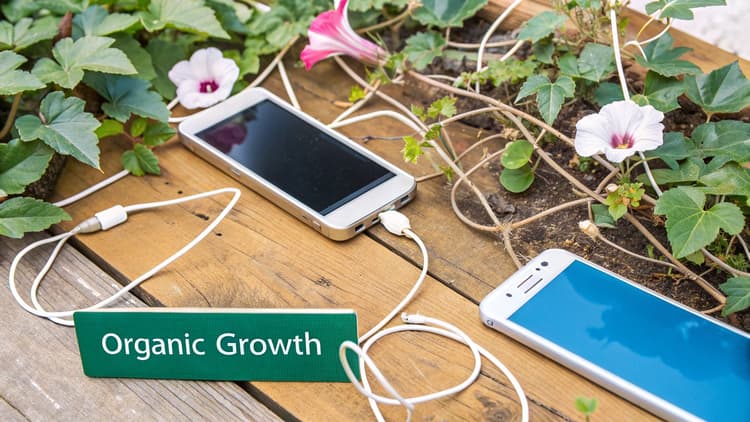Why Keywords Now Matter on Instagram

It’s time for a mental shift. Stop seeing Instagram as just a place for pretty pictures and start seeing it for what it has become: a powerful search engine. The algorithm is no longer just about who you follow or which hashtags are trending. It’s gotten much smarter, behaving more like Google by focusing on relevance and what a user is looking for.
This shift creates a clear divide between two types of users on the platform:
Passive Scrollers: These are the people who casually browse their main feed, looking at content from accounts they already know.
Active Searchers: These users are your golden ticket. They go directly to the search bar or Explore page with a specific problem, interest, or question they need answered.
Reaching "active searchers" is where real, meaningful growth happens. Someone searching for "easy vegan dinner ideas" is infinitely more valuable than a random scroller. They have a clear need, and your goal is to be the solution they find. This is precisely why a deliberate Instagram keyword research process is no longer optional—it's essential.
Building Topical Authority
A huge piece of the Instagram SEO puzzle is what we call topical authority. In simple terms, this means proving to the algorithm that you're a go-to expert in your niche. You do this by consistently using a focused set of keywords across your entire presence.
> When you zero in on your core topics, you send a strong signal to Instagram that your account is a specialized hub of information. This isn't just a random collection of posts; it's a valuable resource. As a result, you start ranking higher for relevant searches and showing up in more user recommendations.
Think of it as creating a consistent theme. Effective Instagram keyword research helps you identify the primary keywords that should appear in your handle, your profile name, and your bio. This unified approach tells the algorithm you know your stuff, which builds trust with both the platform and the new followers you're trying to attract.
To give you a clearer picture, here's a quick rundown of where you should be placing these keywords for the best results.
Where to Place Keywords for Instagram SEO
This list is a quick reference guide to the most critical places to integrate your primary keywords on your Instagram profile for maximum search visibility.
Profile Name:
Include your most important primary keyword in your profile name. This element is heavily weighted in search results and has a high impact on discoverability.Username (@handle):
If possible, include a core keyword in your username. It should be brandable and easy to remember. This also has a high impact on discoverability.Bio:
Naturally weave in your primary and secondary keywords. Use this space to explain who you are and what you do. This contributes a medium-high impact on discoverability.Post Captions:
Use keywords naturally within the first few lines and throughout the caption text. This has a medium impact on discoverability.Hashtags:
Use a mix of broad, niche, and community-specific keywords in your hashtags to expand your reach. Hashtags have a high impact on discoverability.Alt Text:
Describe your image using relevant keywords in the alt text. This not only helps with accessibility but also improves search. The impact here is medium on discoverability.
Strategically placing keywords across these elements creates a powerful, cohesive signal that reinforces your authority on a topic.
Of course, understanding why keywords are so important is just the beginning. For a broader look at building your presence, be sure to check out other proven strategies to grow your Instagram followers.
Building a Modern Hashtag Strategy
Hashtags were Instagram's first search engine, but let's be honest—the old "copy and paste 30 random tags" trick is dead. If you're still doing that, you're leaving the table. Today, a smart hashtag strategy is a crucial piece of your overall Instagram keyword research. It’s less about spamming and more about building an intentional, balanced portfolio of tags that gets you in front of the right people.
Think of yourself as a librarian for your content. Your job is to use hashtags to categorize each post meticulously. This tells the algorithm exactly who to show it to. Forget just chasing the biggest, most popular tags; the real magic happens when you create a strategic mix.
Create a Balanced Hashtag Portfolio
I like to think of a post's hashtag mix like a small investment portfolio. You need to balance high-risk, high-reward options with safer, more targeted bets to get the best results.
For any single post, a well-rounded set of hashtags usually breaks down like this:
High-Volume Tags (1-2): These are the giants, the
#digitalmarketingof the world with 50M+ posts. Use one or two, but do it knowing your content will be a flash in the pan. It's a quick hit of visibility, but you'll be buried in minutes.Niche-Specific Tags (4-6): Here’s where you start to find your people. Think
#smallbusinessmarketingtips(around 1M posts). This is where you connect with an audience actively looking for what you offer.Hyper-Niche or Community Tags (3-4): These are my absolute favorite. Get laser-focused with tags like
#chicagointeriordesignor#veganmealprepsunday. These are your secret weapons for tapping into tight-knit, highly engaged communities that are hungry for your content.
This layered approach means you’re casting a wide net while also dropping a line in smaller, more valuable ponds. To dive deep into this method, you should check out our comprehensive Instagram hashtag strategy guide.
Finding and Organizing Your Hashtags
You don't need a fancy tool to get started. The best place to begin your research is right there in the Instagram app. Just pop a core keyword into the search bar and tap over to the "Tags" tab. Instagram will immediately serve up a list of related hashtags along with their post volume, giving you instant intel on what's trending and what's a hidden gem.
As you find good ones, don't just let them float away. Start organizing them into "hashtag sets" that align with your main content topics. For example, a fitness coach I worked with had separate lists for:
Workout tutorials
Nutrition advice
Mindset and motivation posts
> Pro Tip: Keep these hashtag sets in a simple notes app or a spreadsheet. This simple step saves a ton of time and stops you from reinventing the wheel with every single post. It’s all about creating a system that makes consistency easy.
Caption vs. First Comment: Where to Put Them?
Ah, the great debate. Should hashtags live in the caption or be tucked away in the first comment? People have strong opinions, but the data gives us a clearer picture.
One study found that using 9 to 11 hashtags can boost reach by a staggering 79.5%. Placement makes a difference, too—especially for smaller accounts, where putting tags directly in the caption can increase reach by 36%. And don't forget your branded hashtag; with 70% of all tags now being branded, it's a non-negotiable for building identity. You can dig into the numbers yourself in this thorough analysis of Instagram hashtag statistics.
My advice? Test it. Try both placements for a few weeks, keep a close eye on your analytics, and let your own audience's behavior tell you what works best for your account.
Finding Keywords Your Audience Uses
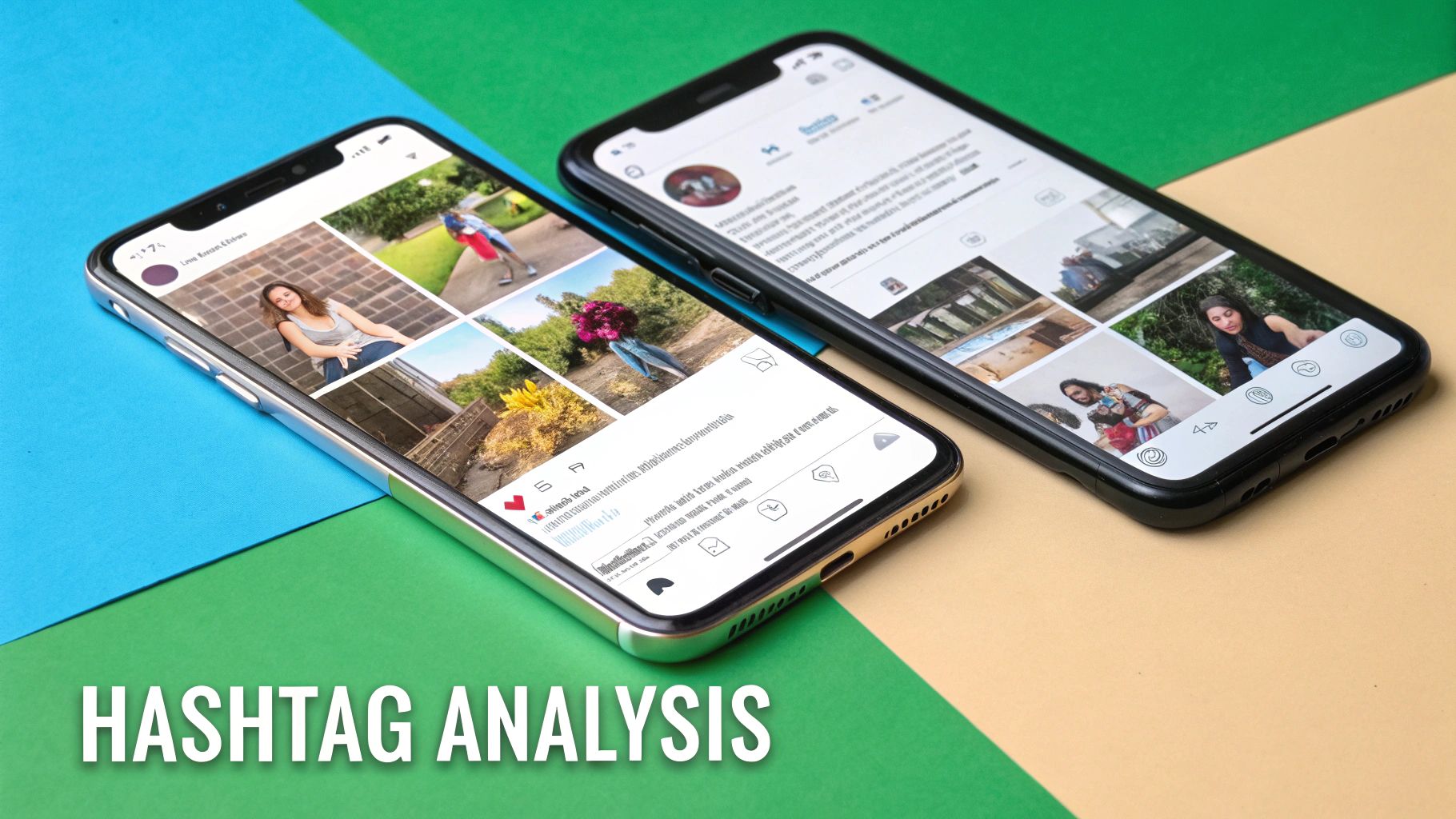
The best keywords aren't the ones you think your audience is using; they're the exact terms people are already typing into the Instagram search bar. Think of your community as a live focus group. The secret to effective Instagram keyword research is simply learning how to listen to them.
Your best keyword ideas are often hiding in plain sight. Start by digging into your own comments section and Direct Messages. What specific questions keep popping up? What problems are your followers trying to solve? The language they use is precisely the language you need to adopt in your captions, bio, and alt text.
Let's say you're in the skincare space. You might be using a broad term like "skincare solutions." But if you notice several followers asking for help with "calming red, irritated skin," you've just found a much better keyword. It's direct, it's authentic, and it proves you're paying attention.
Tap into Your Follower Analytics
Don't just glance at your follower count in Instagram Insights. That section is a goldmine of demographic data, and it’s critical for shaping your keyword strategy. Head over to your audience analytics to see the breakdown of your followers' age, gender, and top locations.
This information is invaluable. Globally, Instagram's user base is massive, but a huge chunk—16.4% of all users—are women between the ages of 18 and 24. If your analytics show this is your core audience, you know your keywords should probably align with trending topics, popular sounds, and current aesthetics.
> By aligning your keywords with your audience's demographics, you move from shouting into the void to having a direct conversation with the people most likely to engage, follow, and convert.
Connecting Demographics to Keywords
Knowing who your audience is tells you what they’re likely searching for. For example, a younger audience might be looking for "DIY dorm room decor," while an older demographic is more likely to search for "modern farmhouse living room ideas." Your analytics give you the roadmap to figure this out.
Here’s how you can turn those insights into a practical keyword list:
Analyze Your DMs: Make it a habit to review your direct messages. Look for recurring questions and common pain points—these are raw, unfiltered keyword ideas straight from the source.
Sift Through Comments: Pay close attention to the specific adjectives and nouns people use when they describe what they love about your posts.
Check Story Replies: Polls and question stickers aren't just for engagement. Use them to ask flat-out what content your audience wants to see next.
This isn't just about finding better keywords; it’s about building a content strategy that truly connects with your community. For a closer look at what’s popular right now, check out our guide on how to https://www.gainsty.com/blog/find-trending-instagram-hashtags. To get even more specific about the language your ideal followers use, you could even explore advanced techniques like learning how to scrape Instagram followers to analyze their bios and posts.
Finding Keyword Gaps in Your Niche
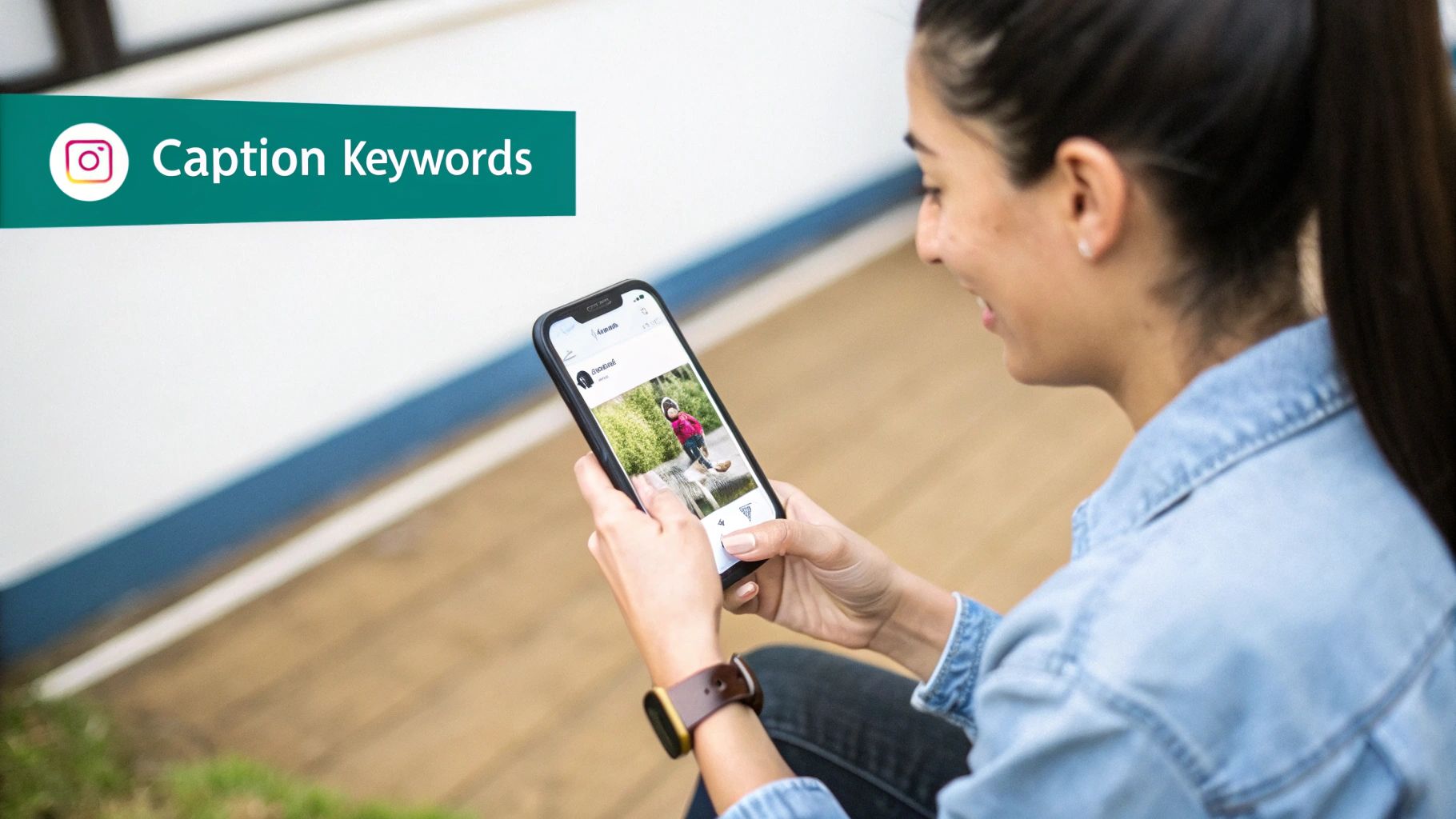
Sometimes the best Instagram keyword research has nothing to do with fancy tools and everything to do with a little clever observation. Think about it: your competitors are out there every single day, testing content, trying new keywords, and throwing hashtags at the wall to see what sticks. By keeping a close eye on their strategy, you get a free education on what works—and more importantly, what they're completely missing.
This isn’t about just copying your competition. The real goal here is to find the "keyword gaps." These are valuable search terms your audience is using, but that the big players in your niche have overlooked. Finding these gaps is your ticket to standing out in a crowded market.
First things first, you need to know who you’re actually up against on Instagram. Don't just list the obvious household names. A good competitor list is a healthy mix.
Major Brands: The big dogs, the established leaders in your field.
Direct Competitors: Accounts that are roughly your size with a similar product or service.
Up-and-Coming Creators: These are the hungry ones—smaller accounts growing fast with super-engaged followers.
Once you’ve got a solid list of 5-10 accounts, it’s time to play detective.
Dissecting Your Competitors' Strategy
This is more than just a quick scroll through their feed. You’re looking for patterns in the language they use to describe themselves and what they do. Start with their bio. What keywords did they choose for their profile name and description? Those are the terms they’re banking on for discovery.
Next, dig into their posts, especially the ones that are getting a lot of love (likes and comments). Read the captions. Read them.
> Pay attention to the subtle differences in phrasing. Are they saying "sustainable activewear" or "eco-friendly workout clothes"? Those small shifts in language can tell you exactly which keywords they're trying to own.
Jot down the hashtags they use again and again. Are they all massive, generic tags, or are they tapping into smaller, niche communities? As you do this for a few competitors, you'll start to see where their strategies overlap. And that’s when you’ll spot what's missing.
Uncovering and Owning the Gaps
As your notes pile up, the gaps will start to jump out at you. Maybe every coffee roaster is hammering the #specialtycoffee hashtag, but no one is talking about "home barista setup tips." That's your opening.
Or perhaps you see all your competitors posting super polished, professional photos, but there's a total lack of content around "behind-the-scenes" or "how it's made" keywords. By targeting these underserved terms, you can pull in a slice of the audience that everyone else is ignoring.
This methodical approach to competitor analysis turns your Instagram keyword research from a wild guess into a strategic plan. You’re not just finding keywords; you’re finding your unique space in the market.
Using Tools for Advanced Keyword Research
Let's be honest: while Instagram's search bar is a decent starting point, relying on it alone is a bit like trying to find a needle in a haystack. If you want to get ahead, dedicated Instagram keyword research tools are your secret weapon. They turn a fuzzy guessing game into a sharp, data-backed strategy.
These platforms are designed to save you countless hours of manual scrolling and deliver insights you simply can’t find within the app. Think beyond just hashtag volume—these tools can track a keyword’s performance over time, help you catch trends as they emerge, and uncover related terms you would have never thought of on your own.
The right tools help you understand the why behind what people are searching for, letting you connect with your audience on a much deeper level.
Just look at the difference a data-driven approach can make. The numbers below show the kind of growth you can expect when you stop guessing and start strategizing.
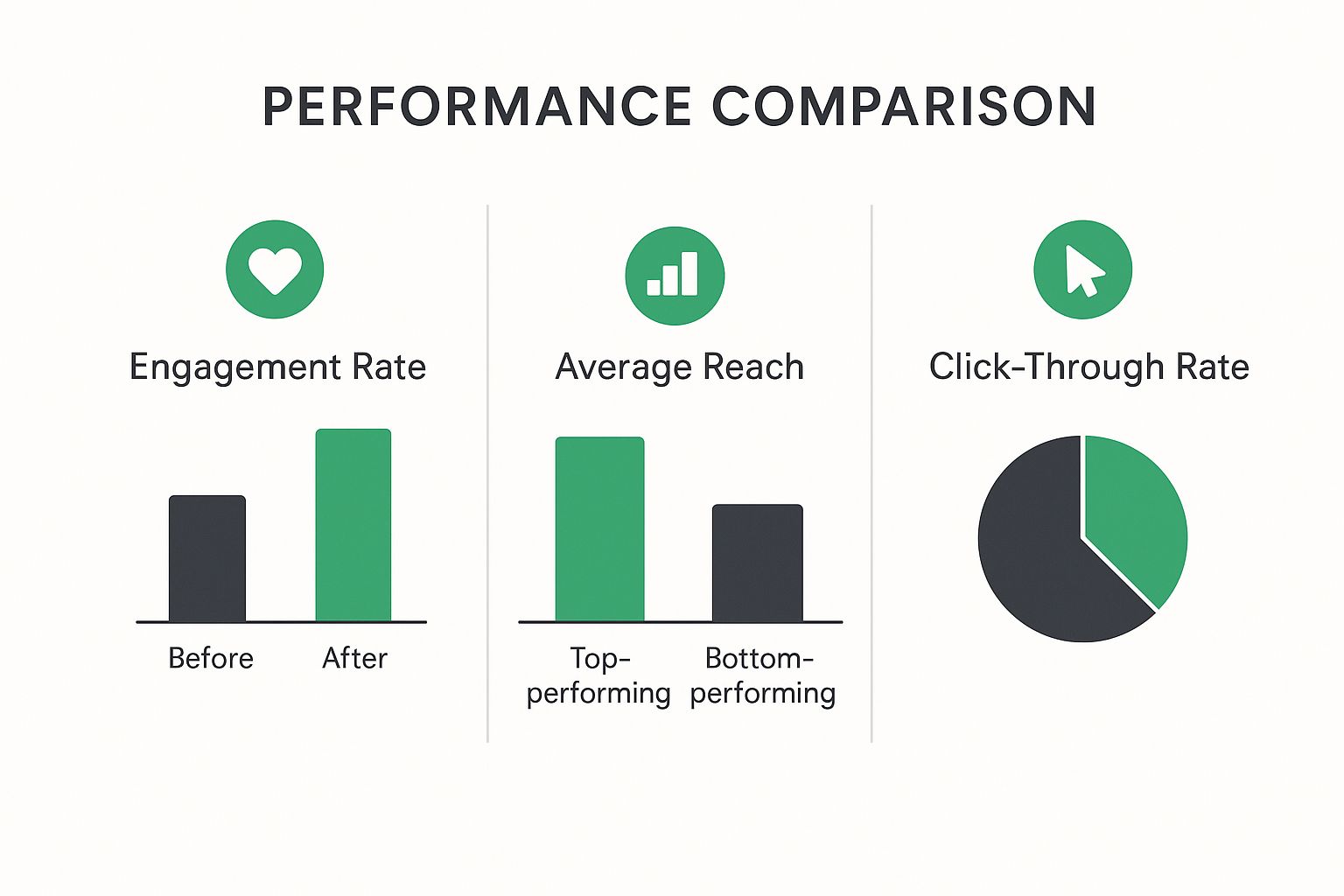
As you can see, optimizing with the right keywords provides a serious boost across the board—from engagement to reach and even click-throughs. It’s clear proof that putting in the research effort pays off in a big way.
Expanding Your Keyword Universe
Here’s a practical example. Say you run a sustainable fashion brand. Your starting point, or "seed keyword," might be something broad like "ethical fashion." A manual search on Instagram will show you the most obvious related hashtags, but that’s where it stops.
A dedicated tool, on the other hand, can take that single term and spin it into a whole web of related keywords. Suddenly, you're looking at a list of high-intent, long-tail phrases that your competitors probably aren't even thinking about, such as:
"Slow fashion for petites"
"vegan leather handbag reviews"
"upcycled denim jacket styling"
These aren't just terms for casual scrollers; they're the phrases used by people who are actively looking to buy. For truly deep insights into keyword volumes, competition, and emerging trends, powerful SEO platforms like SEMrush have social media features that can inform your entire content plan.
> A great tool doesn’t just spit out a list of keywords; it gives you the story behind them. It shows you which terms are gaining traction, which are too crowded, and which ones are golden opportunities waiting for you to claim.
This kind of detailed insight lets you plan your content calendar with total confidence, because you know every single post is targeting a specific, searchable phrase that your ideal customer is already using.
Comparing Instagram Keyword Research Methods
To build a truly effective strategy, you'll want to combine a few different approaches. This list breaks down the most common methods to help you decide where to focus your energy.
Native Instagram Search is best for quick brainstorming and spotting top-level popular tags. It is free, easy to use, and shows real-time popular results. However, it lacks deep data, volume metrics, or trend analysis.
Competitor Analysis is useful for finding proven keywords that already work in your niche. It is highly relevant and provides a competitive benchmark. The downside is that it can be time-consuming and may not reveal new opportunities.
Third-party tools are ideal for in-depth, data-driven research and strategy building. They provide volume, competition data, and trend insights. However, they often require a subscription and come with a learning curve.
Hashtag Analytics helps in optimizing your current strategy and finding related tags. It measures what’s working and uncovers adjacent opportunities. On the flip side, it relies on your existing content and is less useful for new accounts.
Each method has its place. Native search is great for a quick idea, but a dedicated tool is what you need for building a sustainable growth plan.
Choosing the Right Platform
A quick Google search will reveal a flood of tools all promising to skyrocket your social media game. From hashtag generators to performance trackers and competitor analysis features, there's something for every need. Some platforms even use AI to suggest captions and optimize your keyword placement, taking a lot of the heavy lifting off your plate.
By bringing one of these platforms into your workflow, you can completely change how you approach Instagram keyword research. You’ll spend far less time hunting for ideas and more time creating amazing content that you know will find its audience.
The trick is to identify a tool that matches your specific goals, whether that’s discovering niche hashtags or doing a deep dive on your competition. Ultimately, taking the time to build this data-driven foundation is one of the smartest moves you can make to https://www.gainsty.com/blog/find-trending-instagram-hashtags organically.
Answering Your Toughest Instagram Keyword Questions
Even with the best game plan, doing your Instagram keyword research will bring up some real head-scratchers. It's normal. Let's walk through some of the most common questions and roadblocks I see people run into.
Think of this as your go-to troubleshooting guide. Getting these details right is often what separates a strategy that looks good on paper from one that delivers real-world results.
How Do I Find Keywords for a Brand-New Niche?
Starting from a blank slate can feel like you're just guessing. But it's a huge advantage—you get to help define the language of your space. The trick is to start by thinking bigger than just your product.
Think about the problems your ideal customer has before they know a solution like yours even exists. These are your "problem-aware" keywords. For example, if you're launching a new kind of sustainable packaging, your first keywords might not be your product name, but things like "eco-friendly shipping ideas" or "how to reduce business waste." It's also smart to peek at adjacent industries and see what language is already working for them.
Most importantly, you have to listen. Especially to your first few followers.
> Your early adopters are your co-creators. The language they use in comments and DMs is pure gold—they are building the vocabulary for your niche alongside you. Pay close attention and adopt their phrasing.
And don't hesitate to coin your own branded hashtags from day one. It's a fantastic way to start building a community and owning a unique corner of Instagram search.
Should I Use the Same Keywords on Every Post?
That's a hard no. Slapping the same block of keywords or hashtags on every post is a major red flag for the algorithm. It looks lazy, can come across as spammy, and tells Instagram you aren't tailoring your content.
Instead, think in layers. You should have a handful of core keywords that represent the main pillars of your brand. These are the terms that live in your bio and define your overall theme. But for each post, you need to customize your keywords and hashtags to be laser-focused on that specific piece of content.
This targeted approach pays off in two big ways:
Reaching Different Segments: A post about "vegan baking" needs different keywords than one about "plant-based meal prep." This allows you to connect with very specific sub-audiences within your larger niche.
Avoiding Spam Filters: Varying your keywords proves to the algorithm that you're putting in the effort to create diverse, valuable content, not just hitting copy-paste.
How Often Should I Update My Keyword Strategy?
Your keyword strategy should never be a "set it and forget it" task. It's a living, breathing part of your marketing that needs to evolve with your audience and your brand.
As a general rule, I recommend reviewing your core profile keywords—the ones in your name and bio—at least quarterly. This ensures they still perfectly align with your business goals and any new trends that have popped up.
For your daily content, the feedback loop needs to be much faster. I'd check your post insights weekly, or bi-weekly at the latest. Zero in on which hashtags are driving the most impressions and which posts are getting found through search. This agile approach lets you double down on what’s working and ditch what isn't, fast.
What Is the Difference Between Keywords and Hashtags?
This is a fantastic question because people mix them up all the time. They work together, but they do different jobs for your Instagram keyword research.
Think of keywords—the words you use in your captions and alt text—as conversational SEO. They give both users and the algorithm rich context. Writing "Here’s our guide to simple vegan baking for beginners" naturally tells Instagram what the post is about.
Hashtags, on the other hand, are more like digital filing labels for the algorithm. They are clickable topic folders. Using #veganbaking and #plantbasedrecipes explicitly tells Instagram, "File this content under these exact categories." This makes your post discoverable when people search for or follow those specific tags.
One provides context, the other provides categorization. You need both to win.
Ready to stop guessing and start growing? Gainsty uses a powerful combination of expert strategy and advanced AI to attract real, engaged followers to your profile. See how our organic growth service can change your Instagram followers by visiting Gainsty today.
